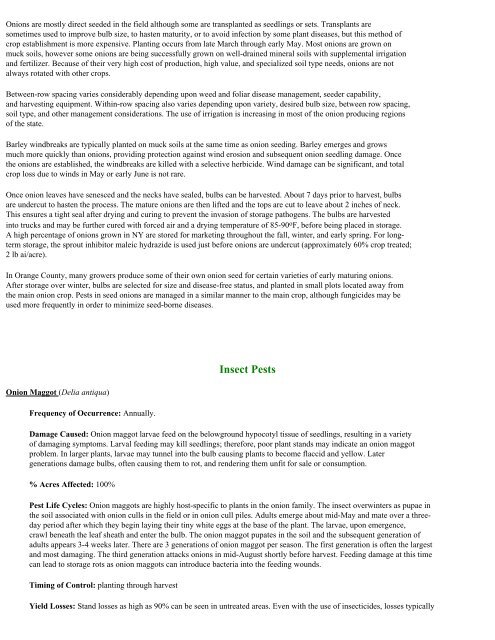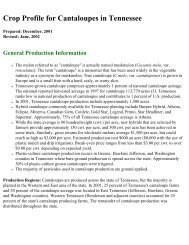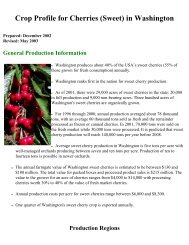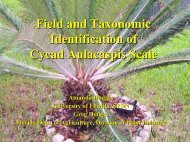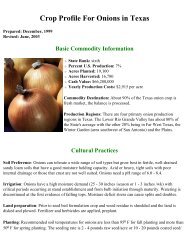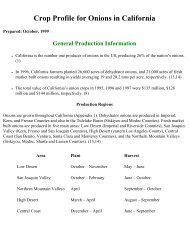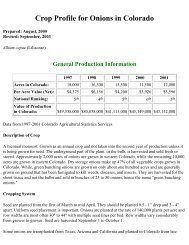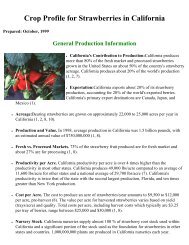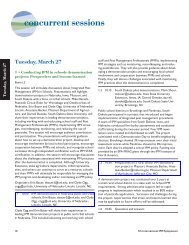Crop Profile for Onions in New York - Regional IPM Centers
Crop Profile for Onions in New York - Regional IPM Centers
Crop Profile for Onions in New York - Regional IPM Centers
Create successful ePaper yourself
Turn your PDF publications into a flip-book with our unique Google optimized e-Paper software.
<strong>Onions</strong> are mostly direct seeded <strong>in</strong> the field although some are transplanted as seedl<strong>in</strong>gs or sets. Transplants are<br />
sometimes used to improve bulb size, to hasten maturity, or to avoid <strong>in</strong>fection by some plant diseases, but this method of<br />
crop establishment is more expensive. Plant<strong>in</strong>g occurs from late March through early May. Most onions are grown on<br />
muck soils, however some onions are be<strong>in</strong>g successfully grown on well-dra<strong>in</strong>ed m<strong>in</strong>eral soils with supplemental irrigation<br />
and fertilizer. Because of their very high cost of production, high value, and specialized soil type needs, onions are not<br />
always rotated with other crops.<br />
Between-row spac<strong>in</strong>g varies considerably depend<strong>in</strong>g upon weed and foliar disease management, seeder capability,<br />
and harvest<strong>in</strong>g equipment. With<strong>in</strong>-row spac<strong>in</strong>g also varies depend<strong>in</strong>g upon variety, desired bulb size, between row spac<strong>in</strong>g,<br />
soil type, and other management considerations. The use of irrigation is <strong>in</strong>creas<strong>in</strong>g <strong>in</strong> most of the onion produc<strong>in</strong>g regions<br />
of the state.<br />
Barley w<strong>in</strong>dbreaks are typically planted on muck soils at the same time as onion seed<strong>in</strong>g. Barley emerges and grows<br />
much more quickly than onions, provid<strong>in</strong>g protection aga<strong>in</strong>st w<strong>in</strong>d erosion and subsequent onion seedl<strong>in</strong>g damage. Once<br />
the onions are established, the w<strong>in</strong>dbreaks are killed with a selective herbicide. W<strong>in</strong>d damage can be significant, and total<br />
crop loss due to w<strong>in</strong>ds <strong>in</strong> May or early June is not rare.<br />
Once onion leaves have senesced and the necks have sealed, bulbs can be harvested. About 7 days prior to harvest, bulbs<br />
are undercut to hasten the process. The mature onions are then lifted and the tops are cut to leave about 2 <strong>in</strong>ches of neck.<br />
This ensures a tight seal after dry<strong>in</strong>g and cur<strong>in</strong>g to prevent the <strong>in</strong>vasion of storage pathogens. The bulbs are harvested<br />
<strong>in</strong>to trucks and may be further cured with <strong>for</strong>ced air and a dry<strong>in</strong>g temperature of 85-90 o F, be<strong>for</strong>e be<strong>in</strong>g placed <strong>in</strong> storage.<br />
A high percentage of onions grown <strong>in</strong> NY are stored <strong>for</strong> market<strong>in</strong>g throughout the fall, w<strong>in</strong>ter, and early spr<strong>in</strong>g. For longterm<br />
storage, the sprout <strong>in</strong>hibitor maleic hydrazide is used just be<strong>for</strong>e onions are undercut (approximately 60% crop treated;<br />
2 lb ai/acre).<br />
In Orange County, many growers produce some of their own onion seed <strong>for</strong> certa<strong>in</strong> varieties of early matur<strong>in</strong>g onions.<br />
After storage over w<strong>in</strong>ter, bulbs are selected <strong>for</strong> size and disease-free status, and planted <strong>in</strong> small plots located away from<br />
the ma<strong>in</strong> onion crop. Pests <strong>in</strong> seed onions are managed <strong>in</strong> a similar manner to the ma<strong>in</strong> crop, although fungicides may be<br />
used more frequently <strong>in</strong> order to m<strong>in</strong>imize seed-borne diseases.<br />
Onion Maggot (Delia antiqua)<br />
Frequency of Occurrence: Annually.<br />
Insect Pests<br />
Damage Caused: Onion maggot larvae feed on the belowground hypocotyl tissue of seedl<strong>in</strong>gs, result<strong>in</strong>g <strong>in</strong> a variety<br />
of damag<strong>in</strong>g symptoms. Larval feed<strong>in</strong>g may kill seedl<strong>in</strong>gs; there<strong>for</strong>e, poor plant stands may <strong>in</strong>dicate an onion maggot<br />
problem. In larger plants, larvae may tunnel <strong>in</strong>to the bulb caus<strong>in</strong>g plants to become flaccid and yellow. Later<br />
generations damage bulbs, often caus<strong>in</strong>g them to rot, and render<strong>in</strong>g them unfit <strong>for</strong> sale or consumption.<br />
% Acres Affected: 100%<br />
Pest Life Cycles: Onion maggots are highly host-specific to plants <strong>in</strong> the onion family. The <strong>in</strong>sect overw<strong>in</strong>ters as pupae <strong>in</strong><br />
the soil associated with onion culls <strong>in</strong> the field or <strong>in</strong> onion cull piles. Adults emerge about mid-May and mate over a threeday<br />
period after which they beg<strong>in</strong> lay<strong>in</strong>g their t<strong>in</strong>y white eggs at the base of the plant. The larvae, upon emergence,<br />
crawl beneath the leaf sheath and enter the bulb. The onion maggot pupates <strong>in</strong> the soil and the subsequent generation of<br />
adults appears 3-4 weeks later. There are 3 generations of onion maggot per season. The first generation is often the largest<br />
and most damag<strong>in</strong>g. The third generation attacks onions <strong>in</strong> mid-August shortly be<strong>for</strong>e harvest. Feed<strong>in</strong>g damage at this time<br />
can lead to storage rots as onion maggots can <strong>in</strong>troduce bacteria <strong>in</strong>to the feed<strong>in</strong>g wounds.<br />
Tim<strong>in</strong>g of Control: plant<strong>in</strong>g through harvest<br />
Yield Losses: Stand losses as high as 90% can be seen <strong>in</strong> untreated areas. Even with the use of <strong>in</strong>secticides, losses typically


